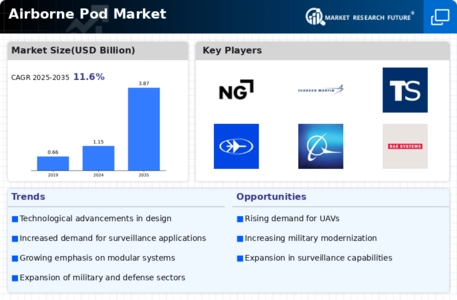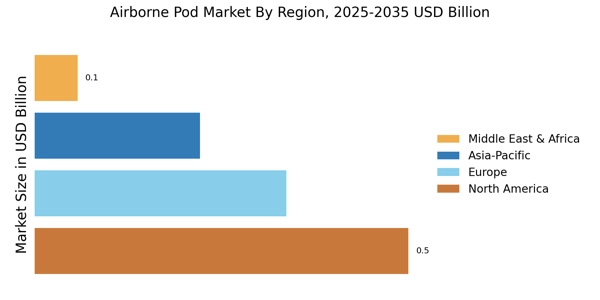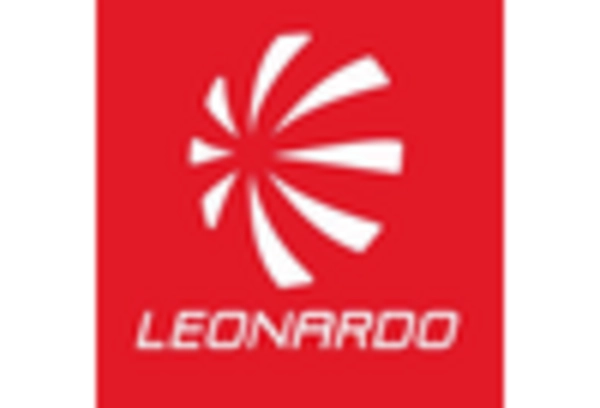Increased Defense Spending
The Airborne Pod Market is experiencing a notable surge due to increased defense spending across various nations. Governments are prioritizing modernization of their military capabilities, which includes the procurement of advanced airborne systems. For instance, defense budgets in several countries have seen an uptick, with projections indicating a compound annual growth rate of approximately 3.5% over the next five years. This trend is likely to drive demand for airborne pods, as they are integral to enhancing surveillance, reconnaissance, and combat capabilities. The emphasis on national security and geopolitical tensions further fuels this growth, as nations seek to bolster their aerial capabilities. Consequently, the Airborne Pod Market is poised for expansion, with manufacturers focusing on innovative designs and technologies to meet the evolving needs of defense forces.
Rising Demand for ISR Capabilities
The Airborne Pod Market is significantly influenced by the rising demand for Intelligence, Surveillance, and Reconnaissance (ISR) capabilities. As military operations become increasingly complex, the need for real-time data and situational awareness has never been more critical. The market for ISR systems is projected to grow at a rate of 4.2% annually, reflecting the urgency for advanced airborne solutions. Airborne pods equipped with sophisticated sensors and imaging technologies are essential for gathering actionable intelligence. This demand is not limited to military applications; law enforcement and disaster response agencies are also seeking enhanced ISR capabilities. As a result, the Airborne Pod Market is adapting to meet these diverse requirements, leading to innovations in pod design and functionality.
Emerging Applications in Civilian Sectors
Emerging applications in civilian sectors are increasingly influencing the Airborne Pod Market. Beyond traditional military uses, airborne pods are finding roles in areas such as environmental monitoring, disaster management, and agricultural surveillance. The market for civilian drones is expected to grow at a rate of 12% annually, creating opportunities for airborne pod manufacturers to diversify their offerings. These pods can be equipped with specialized sensors for tasks such as crop monitoring and wildlife tracking, thereby expanding their utility. As industries recognize the benefits of aerial data collection, the demand for innovative airborne pod solutions is likely to rise. This diversification into civilian applications is expected to contribute to the overall growth of the Airborne Pod Market, fostering a more dynamic and competitive landscape.
Technological Innovations in Sensor Systems
Technological innovations in sensor systems are driving transformation within the Airborne Pod Market. The integration of cutting-edge technologies such as artificial intelligence, machine learning, and advanced imaging systems is enhancing the capabilities of airborne pods. These innovations allow for improved data processing, target identification, and threat assessment. The market for sensor technologies is expected to grow significantly, with estimates suggesting a value increase of over 5 billion USD by 2027. As military and civilian applications demand more sophisticated solutions, manufacturers are investing in research and development to create next-generation airborne pods. This focus on technological advancement is likely to redefine operational effectiveness in various sectors, thereby propelling the Airborne Pod Market forward.
Growing Use of Unmanned Aerial Vehicles (UAVs)
The growing use of Unmanned Aerial Vehicles (UAVs) is a pivotal driver for the Airborne Pod Market. UAVs are increasingly being deployed for a variety of missions, including surveillance, reconnaissance, and logistics. The market for UAVs is projected to expand at a compound annual growth rate of 15% over the next five years, indicating a robust demand for compatible airborne pods. These pods enhance the functionality of UAVs by providing additional payload options and advanced sensor capabilities. As military and commercial sectors recognize the advantages of UAVs, the integration of airborne pods becomes essential for maximizing operational efficiency. This trend is likely to stimulate innovation within the Airborne Pod Market, as manufacturers strive to develop versatile and adaptable pod solutions.


















Leave a Comment